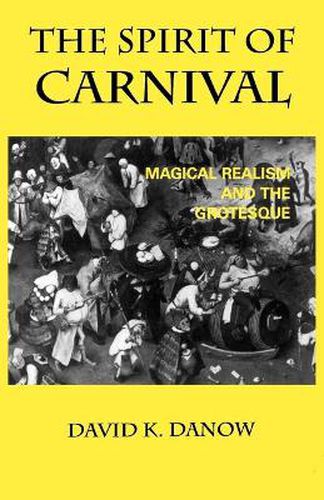Readings Newsletter
Become a Readings Member to make your shopping experience even easier.
Sign in or sign up for free!
You’re not far away from qualifying for FREE standard shipping within Australia
You’ve qualified for FREE standard shipping within Australia
The cart is loading…






The world of literature responds to the spirit of carnival in ways that are both social and cultural, mythological and archetypal. Literature provides a mirror in which carnival is reflected and refracted through the multifarious perspectives of verbal art. In his original, wide-ranging book, David K. Danow catches the various reflections in that mirror, from the bright, life-affirming magical side of carnival, as revealed in the literature of Latin American writers, to its dark, grotesque, death-embracing aspect as illustrated in numerous novels depicting the dire experience of the Second World War. The remarkable meshing of these two diametrically opposed yet inextricably intertwined facets of literature (and of life) makes for an intriguing sphere of investigation, for the carnival spirit is animated by a human need to dissolve borders and eliminate boundaries – including, symbolically, those between life and death – in an ongoing effort to merge opposing forces into new configurations of truth and meaning. Expanding upon the seminal ideas of Mikhail Bakhtin, carnival, argues Danow, is designed to allow one extreme to flow into another, to provide for one polarity (official culture) to confront its opposite (unofficial culture), much as individuals engage in dialogue. In this case the result is dialogized carnival or carnivalized dialogue. In their artmaking, Danow claims, human beings are animated by a periodic predisposition toward the bright side of carnival, matched by an equally strong, far darker predilection. Carnival forms of thinking are firmly embedded within the human psyche as archetypal patterns. In this engaging exploratory book, we are shown the distinctive imprint of these primordial structures within a multitude of seemingly disparate literary works.
$9.00 standard shipping within Australia
FREE standard shipping within Australia for orders over $100.00
Express & International shipping calculated at checkout
The world of literature responds to the spirit of carnival in ways that are both social and cultural, mythological and archetypal. Literature provides a mirror in which carnival is reflected and refracted through the multifarious perspectives of verbal art. In his original, wide-ranging book, David K. Danow catches the various reflections in that mirror, from the bright, life-affirming magical side of carnival, as revealed in the literature of Latin American writers, to its dark, grotesque, death-embracing aspect as illustrated in numerous novels depicting the dire experience of the Second World War. The remarkable meshing of these two diametrically opposed yet inextricably intertwined facets of literature (and of life) makes for an intriguing sphere of investigation, for the carnival spirit is animated by a human need to dissolve borders and eliminate boundaries – including, symbolically, those between life and death – in an ongoing effort to merge opposing forces into new configurations of truth and meaning. Expanding upon the seminal ideas of Mikhail Bakhtin, carnival, argues Danow, is designed to allow one extreme to flow into another, to provide for one polarity (official culture) to confront its opposite (unofficial culture), much as individuals engage in dialogue. In this case the result is dialogized carnival or carnivalized dialogue. In their artmaking, Danow claims, human beings are animated by a periodic predisposition toward the bright side of carnival, matched by an equally strong, far darker predilection. Carnival forms of thinking are firmly embedded within the human psyche as archetypal patterns. In this engaging exploratory book, we are shown the distinctive imprint of these primordial structures within a multitude of seemingly disparate literary works.